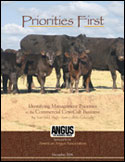Tongue Twister
Cows like leaves their tongues can wrap around easily.
Lots of leaves growing in easy reach of a cow's tongue means less time and less land needed to raise beef cattle, according to Agricultural Research Service (ARS) and DairyNZ (New Zealand) scientists.
Ranchers may be able to tell how long to leave cattle in a pasture, and how large to make the pasture, by the height and leafiness of plants growing there, according to Stacey Gunter, research leader at the ARS Southern Plains Range Research Station in Woodward, Okla. He worked with former doctoral student Pablo Gregorini and colleagues at Woodward to demonstrate this approach with beef steers grazing in fenced-off corridors in wheat pastures.
The pastures were chosen to represent a range of natural variations in plant heights and upper plant leafiness. The steers were allowed to graze the corridors freely and were removed when they reached the end of the corridor, regardless of how much time the steers took. While grazing the corridors, each steer was videotaped and had two trained observers who counted bites and walking steps.
The reason for this real-life pasture study is that most studies of grazing behavior are done on "artificial seedings," specially planted pastures, or small plots that are fairly uniform. To provide the best possible recommendations to ranchers, Gunter and Gregorini integrated studies of the standard type with "in field" pasture conditions, which are much less uniform.
Besides the taste and nutrition of large leaves, cattle like their food to be accessible, with leaves high on the plant and a minimum of stem interference with the cattle's tongues, which they use to wrap around and pull off leaves. Cattle faced with a nice canopy of luscious leaves took larger bites and were able to get their daily rations with lower calorie expenditure.
This resulted in greater eating efficiency. Gunter and Gregorini measured eating efficiency by dividing the total amount of pasture plants eaten per steer by the total eating time. This is known as herbage intake rate, a key determinant of weight gain for cattle grazing pasture.
The research was published in the Journal of Animal Science.





